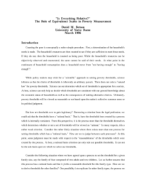
An official website of the United States government
Here’s how you know
Official websites use .gov
A .gov website belongs to an official government organization in the United States.
Secure .gov websites use HTTPS
A lock (
) or https:// means you’ve safely connected to the .gov website. Share sensitive information only on official, secure websites.
-
//
- Census.gov /
- Library /
- Census Working Papers /
- The Role of Equivalence Scales in Poverty Measurement
"Is Everything Relative?" The Role of Equivalence Scales in Poverty Measurement
"Is Everything Relative?" The Role of Equivalence Scales in Poverty Measurement
Abstract
Counting the poor is conceptually a rather simple procedure. First, a determination of the household's needs is made. The household's resources are then counted to see if they are sufficient to meet these needs. If they do not, then the household is counted as being poor. While the household's resources can be objectively observed and enumerated, the same cannot be said of their needs. At what point in the continuum of household consumption does a household move from "not having enough" to "having enough"?
This discussion underscores the role equivalence scales can play in the setting of poverty thresholds. They will either be used as a basis to judge whether or not a set of thresholds are reasonable or they will be directly used in setting of the thresholds. But clearly, this implies that a "reasonable" set of scales must exist. This paper addresses this question in a three part fashion. First, we examine the scales implicit in the current poverty thresholds and ask, are they reasonable? Second, we will turn to the more thorny question, what are reasonable equivalence scales? Finally, we will explore the consequences of alternative scales on perceptions of who is considered poor.
Others in Series
Working Paper
Working Paper
Working Paper
Share
Related Information
WORKING PAPER
Supplemental Poverty Measure Working PapersSome content on this site is available in several different electronic formats. Some of the files may require a plug-in or additional software to view.
 Yes
Yes
 No
NoComments or suggestions?


Top

